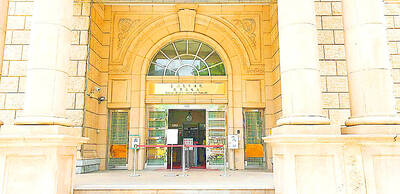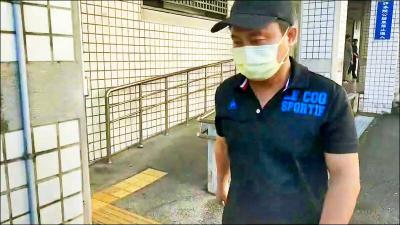Modified standards to allow people who have tested positive for COVID-19, but have no symptoms, to be released from isolation after arriving from overseas are to be implemented today, the Central Epidemic Command Center (CECC) said yesterday.
Minister of Health and Welfare Chen Shih-chung (陳時中), who heads the center, said that from today, asymptomatic individuals who test positive for COVID-19 after arriving in Taiwan would be divided into two groups.
The first group is “arriving travelers who have been diagnosed with COVID-19 in other countries and later tested negative twice before entering Taiwan,” Chen said.
He said that they would be released from isolation if they meet three requirements: They show no symptoms; they have tested positive for antibodies against SARS-CoV-2, the virus that causes COVID-19; and the first respiratory specimen collected in Taiwan has a low viral load — a cycle threshold (CT) value of 34 or higher in a polymerase chain reaction (PCR) test — and a follow-up PCR test taken within three days is negative, or has a CT value of 34 or higher.
The second group is “arriving travelers who have not been diagnosed with COVID-19 in other countries, but tested positive after completing quarantine in Taiwan,” Chen said, adding that there are three requirements for them to be released from isolation:
They must test positive for the immunoglobulin G antibody and negative for the immunoglobulin M antibody, and the other two requirements are the same as the first and third in the other group, he said.
“The specialists believe that people who meet these requirements would not pose an infection risk to others, so they can be released from isolation,” he said.
A new imported case of COVID-19 was confirmed yesterday, a Philippine migrant worker in his 20s who arrived in Taiwan on Feb. 28, Chen said.
The man had provided a negative result from a PCR test conducted within three days of boarding his flight to Taiwan, and was not symptomatic upon arrival, but during quarantine on Thursday last week he reported mild coughing and a fever, and a test result returned positive yesterday, Chen said.
As local COVID-19 outbreaks have been reported in East Timor and Mauritius, the two nations have been moved from the list of low-risk infection countries or areas to medium-low infection risk countries or areas, from which short-term business travelers can apply for shortened quarantine periods, Chen said.
Hong Kong has been added to the list of medium-low infection risk countries or areas, he said.
Asked when the first batch of about 117,000 doses of the AstraZeneca COVID-19 vaccine, which arrived in Taiwan on Wednesday last week, would be administered, Chen said that they are in the final step of a Food and Drug Administration lot release procedure required for biological products.
There are seven items to be reviewed and tested in the procedure, and the AstraZeneca vaccines have passed six, with the last step a sterility test, he said, adding that they would be released as soon as they pass the test.
Asked about a plan to establish a “travel bubble” between Taiwan and Palau, Chen said that the two nations have agreed on an overall plan, although some details need to be ironed out, including that Palau had hoped visitors from Taiwan would be required to receive a rapid antigen test upon arrival there, but the CECC disagreed.
The center believes that antigen tests can produce a relatively high rate of false positives, which would likely ruin many travel plans, he said.
The CECC hopes to rely on a more accurate PCR test conducted in Taiwan before traveling, but the two sides have not reached an agreement yet, he said.
As for quarantine rules for Taiwanese visitors returning from Palau, Chen said that the center leans toward requiring them to practice five days of “enhanced self-health management,” followed by a PCR test, and another nine days of self-health management if they test negative.

South Korean K-pop girl group Blackpink are to make Kaohsiung the first stop on their Asia tour when they perform at Kaohsiung National Stadium on Oct. 18 and 19, the event organizer said yesterday. The upcoming performances will also make Blackpink the first girl group ever to perform twice at the stadium. It will be the group’s third visit to Taiwan to stage a concert. The last time Blackpink held a concert in the city was in March 2023. Their first concert in Taiwan was on March 3, 2019, at NTSU Arena (Linkou Arena). The group’s 2022-2023 “Born Pink” tour set a

CPBL players, cheerleaders and officials pose at a news conference in Taipei yesterday announcing the upcoming All-Star Game. This year’s CPBL All-Star Weekend is to be held at the Taipei Dome on July 19 and 20.

The Taiwan High Court yesterday upheld a lower court’s decision that ruled in favor of former president Tsai Ing-wen (蔡英文) regarding the legitimacy of her doctoral degree. The issue surrounding Tsai’s academic credentials was raised by former political talk show host Dennis Peng (彭文正) in a Facebook post in June 2019, when Tsai was seeking re-election. Peng has repeatedly accused Tsai of never completing her doctoral dissertation to get a doctoral degree in law from the London School of Economics and Political Science (LSE) in 1984. He subsequently filed a declaratory action charging that

The Hualien Branch of the High Court today sentenced the main suspect in the 2021 fatal derailment of the Taroko Express to 12 years and six months in jail in the second trial of the suspect for his role in Taiwan’s deadliest train crash. Lee Yi-hsiang (李義祥), the driver of a crane truck that fell onto the tracks and which the the Taiwan Railways Administration's (TRA) train crashed into in an accident that killed 49 people and injured 200, was sentenced to seven years and 10 months in the first trial by the Hualien District Court in 2022. Hoa Van Hao, a